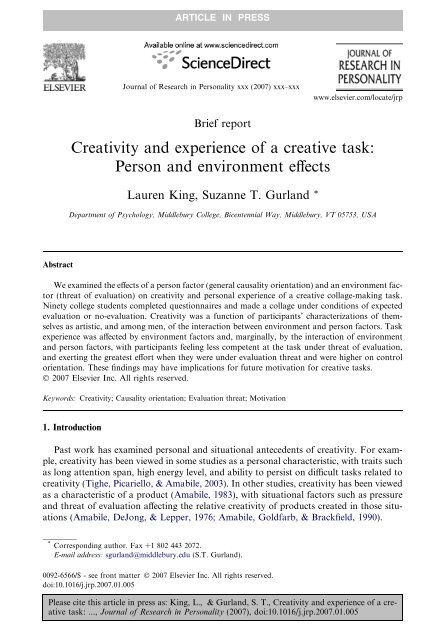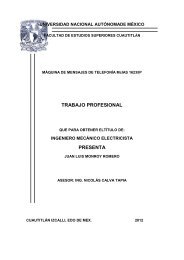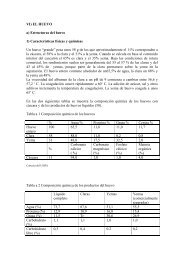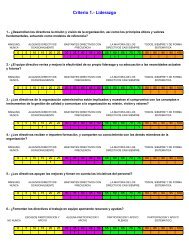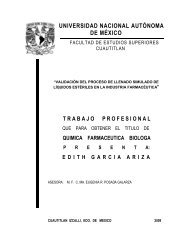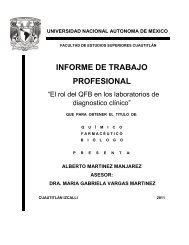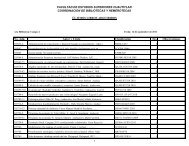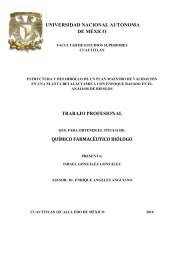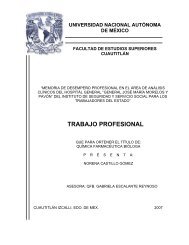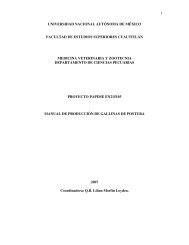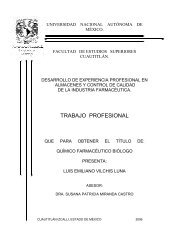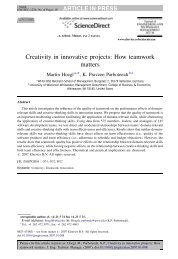Creativity and experience of a creative task: Person and ...
Creativity and experience of a creative task: Person and ...
Creativity and experience of a creative task: Person and ...
Create successful ePaper yourself
Turn your PDF publications into a flip-book with our unique Google optimized e-Paper software.
ARTICLE IN PRESSJournal <strong>of</strong> Research in <strong>Person</strong>ality xxx (2007) xxx–xxxwww.elsevier.com/locate/jrpBrief report<strong>Creativity</strong> <strong>and</strong> <strong>experience</strong> <strong>of</strong> a <strong>creative</strong> <strong>task</strong>:<strong>Person</strong> <strong>and</strong> environment effectsLauren King, Suzanne T. Gurl<strong>and</strong> *Department <strong>of</strong> Psychology, Middlebury College, Bicentennial Way, Middlebury, VT 05753, USAAbstractWe examined the effects <strong>of</strong> a person factor (general causality orientation) <strong>and</strong> an environment factor(threat <strong>of</strong> evaluation) on creativity <strong>and</strong> personal <strong>experience</strong> <strong>of</strong> a <strong>creative</strong> collage-making <strong>task</strong>.Ninety college students completed questionnaires <strong>and</strong> made a collage under conditions <strong>of</strong> expectedevaluation or no-evaluation. <strong>Creativity</strong> was a function <strong>of</strong> participants’ characterizations <strong>of</strong> themselvesas artistic, <strong>and</strong> among men, <strong>of</strong> the interaction between environment <strong>and</strong> person factors. Task<strong>experience</strong> was affected by environment factors <strong>and</strong>, marginally, by the interaction <strong>of</strong> environment<strong>and</strong> person factors, with participants feeling less competent at the <strong>task</strong> under threat <strong>of</strong> evaluation,<strong>and</strong> exerting the greatest effort when they were under evaluation threat <strong>and</strong> were higher on controlorientation. These findings may have implications for future motivation for <strong>creative</strong> <strong>task</strong>s.Ó 2007 Elsevier Inc. All rights reserved.Keywords: <strong>Creativity</strong>; Causality orientation; Evaluation threat; Motivation1. IntroductionPast work has examined personal <strong>and</strong> situational antecedents <strong>of</strong> creativity. For example,creativity has been viewed in some studies as a personal characteristic, with traits suchas long attention span, high energy level, <strong>and</strong> ability to persist on difficult <strong>task</strong>s related tocreativity (Tighe, Picariello, & Amabile, 2003). In other studies, creativity has been viewedas a characteristic <strong>of</strong> a product (Amabile, 1983), with situational factors such as pressure<strong>and</strong> threat <strong>of</strong> evaluation affecting the relative creativity <strong>of</strong> products created in those situations(Amabile, DeJong, & Lepper, 1976; Amabile, Goldfarb, & Brackfield, 1990).* Corresponding author. Fax +1 802 443 2072.E-mail address: sgurl<strong>and</strong>@middlebury.edu (S.T. Gurl<strong>and</strong>).0092-6566/$ - see front matter Ó 2007 Elsevier Inc. All rights reserved.doi:10.1016/j.jrp.2007.01.005Please cite this article in press as: King, L., & Gurl<strong>and</strong>, S. T., <strong>Creativity</strong> <strong>and</strong> <strong>experience</strong> <strong>of</strong> a <strong>creative</strong><strong>task</strong>: ..., Journal <strong>of</strong> Research in <strong>Person</strong>ality (2007), doi:10.1016/j.jrp.2007.01.005
ARTICLE IN PRESS2 L. King, S.T. Gurl<strong>and</strong> / Journal <strong>of</strong> Research in <strong>Person</strong>ality xxx (2007) xxx–xxxThe link between these situational variables <strong>and</strong> creativity is thought to be mediated bytype <strong>of</strong> motivation, with intrinsic motivation associated with greater creativity than extrinsicmotivation (Amabile, 1983). In other words, the greatest creativity is found in <strong>creative</strong>pursuits undertaken for the sake <strong>of</strong> the activity itself, <strong>and</strong> not for the sake <strong>of</strong> some otherend (Amabile et al., 1976, 1990; Amabile & Hennessey, 1992; Conti, Amabile, & Pollack,1995; Csikszentmihalyi, 1996; Koestner, Ryan, Bernieri, & Holt, 1984; Lepper & Greene,1978). Thus, environments that undermine intrinsic motivation by imposing deadlines,surveillance, or the expectation <strong>of</strong> evaluation, result in less <strong>creative</strong> products than environmentsthat enhance intrinsic motivation (though, cf., Eisenberger & Cameron, 1996).In practical settings, such as work <strong>and</strong> school, however, <strong>creative</strong> <strong>task</strong>s are <strong>of</strong>ten necessarilyundertaken as extrinsically motivated activities. A writing assignment must be completedby the deadline for the sake <strong>of</strong> meeting course requirements <strong>and</strong> will be evaluated bya teacher. Similarly, a <strong>creative</strong> new advertisement must be developed for the sake <strong>of</strong> pleasinga client. Under such circumstances, we might wish to know not only about the creativity<strong>of</strong> the product, but also about the <strong>experience</strong> <strong>of</strong> creating the product.Why would quality <strong>of</strong> <strong>experience</strong> be important? First, how people feel during a <strong>task</strong> isindicative <strong>of</strong> their type <strong>of</strong> motivation. According to self-determination theory (Deci &Ryan, 1985a), when people feel pressured, when they feel like they have to do something,it is a sign that they are ‘externally’ motivated—that is, that they are engaging in the activityfor the sake <strong>of</strong> some reward or inducement. When they feel relaxed, on the other h<strong>and</strong>,this is a sign that their motivation is more ‘identified’—that is, that they are engaging inthe activity for reasons that are consistent with their own goals <strong>and</strong> values. Thus, examiningpeople’s <strong>experience</strong> <strong>of</strong> <strong>creative</strong> <strong>task</strong>s can give us specific information about individualparticipants’ motivation, beyond the motivational consequences that are, on average,found to be associated with particular situational factors. Second, people’s <strong>experience</strong>might affect their future motivation for engaging in similar <strong>task</strong>s. Feelings <strong>of</strong> incompetence<strong>and</strong> pressure or anxiety, for example, can undermine one’s intrinsic motivation (Deci &Ryan, 1985a). It is important to know, then, not only individuals’ creativity on a <strong>task</strong> rightnow, but also how their <strong>experience</strong> <strong>of</strong> that <strong>task</strong> might affect future engagement.The effect <strong>of</strong> situational circumstances on quality <strong>of</strong> <strong>experience</strong> <strong>and</strong> on creativity mightbe moderated, however, by individual differences. Specifically, as predicted by self-determinationtheory, people’s general causality orientation is associated with the way theyinterpret situational factors (Deci, Koestner, & Ryan, 1999; Deci & Ryan, 1985b). Thosewho are high in autonomous orientation tend to interpret situational events as opportunitiesfor choice, challenge, <strong>and</strong> personal enjoyment. They then organize their behavioraround these opportunities. By contrast, those high in control orientation tend to orienttoward, <strong>and</strong> interpret the environment as <strong>of</strong>fering, rules, contingencies <strong>and</strong> external constraints.They organize their behavior around these external structures. Thus, a situationalfactor such as the presence or absence <strong>of</strong> evaluation might have different effects on individualswith different causality orientations.In the current study, we extend earlier work by examining quality <strong>of</strong> <strong>experience</strong> <strong>of</strong> a<strong>creative</strong> <strong>task</strong> as well as the creativity <strong>of</strong> the work produced. In addition, while earlier workhas examined person <strong>and</strong> situation effects on creativity separately, little is know about howthese factors might interact to affect <strong>experience</strong>s <strong>and</strong> creativity. We therefore measuredcausality orientation <strong>and</strong> experimentally manipulated threat <strong>of</strong> evaluation. We examineboth <strong>of</strong> these variables <strong>and</strong> their interaction with respect to two outcomes—<strong>experience</strong><strong>of</strong> a collage-making <strong>task</strong> <strong>and</strong> the creativity <strong>of</strong> the resulting collages.Please cite this article in press as: King, L., & Gurl<strong>and</strong>, S. T., <strong>Creativity</strong> <strong>and</strong> <strong>experience</strong> <strong>of</strong> a <strong>creative</strong><strong>task</strong>: ..., Journal <strong>of</strong> Research in <strong>Person</strong>ality (2007), doi:10.1016/j.jrp.2007.01.005
ARTICLE IN PRESSL. King, S.T. Gurl<strong>and</strong> / Journal <strong>of</strong> Research in <strong>Person</strong>ality xxx (2007) xxx–xxx 32. Method2.1. ParticipantsNinety college students (33 male, 57 female) participated, either in partial fulfillment <strong>of</strong>course requirements, or in exchange for a free cookie at a campus restaurant. Most wereWhite (74.4%), <strong>and</strong> the remainder were Hispanic (6.7%), Asian (11.1%), or <strong>of</strong> mixed origin(7.8%).2.2. ProcedureIn individual, 30-min sessions, participants completed a questionnaire measure <strong>of</strong> causalityorientation, <strong>and</strong> were r<strong>and</strong>omly assigned to either an evaluation condition, in whichthey were led to believe that a team <strong>of</strong> judges would later produce a detailed critique <strong>of</strong>their collage, or a no-evaluation condition, in which they were given the cover story thatthe experimenter was only interested in how the collage activity would affect their mood.All participants were provided with a st<strong>and</strong>ard set <strong>of</strong> materials, including scissors, glue,<strong>and</strong> sheets <strong>of</strong> construction paper <strong>of</strong> various sizes <strong>and</strong> colors, <strong>and</strong> were told, followingAmabile (1977):Before you are the materials you will use for the collage activity. You will have about15 minutes to work. You will be using the colored pieces <strong>of</strong> paper to make a collagedesign on the white piece <strong>of</strong> paper. You can use whatever pieces you would like inwhatever way you would like. There are two things to keep in mind: First, pleasedo not use any materials other than the ones laid out before you. If you have a pencil,pen, or paper in your jacket, book bag, or purse, please do not use them in thisactivity. Second, I would like you to make a collage that expresses a sense <strong>of</strong> ‘‘joy.’’Try as much as possible to make your collage convey a feeling <strong>of</strong> joy (p. 78).The theme <strong>of</strong> ‘‘joy’’ was prescribed to prevent participants from selecting their ownthemes, some <strong>of</strong> which might have systematically led to greater or lesser creativity. Participantsthen completed additional questionnaires tapping their <strong>task</strong> <strong>experience</strong>, <strong>and</strong> selfratedhow artistic they are.2.3. Measures2.3.1. Causality orientationsThe General Causality Orientations Scale (GCOS; Deci & Ryan, 1985b) measures theextent to which respondents orient toward opportunities for autonomy in the environment(autonomous orientation) versus environmental controls <strong>and</strong> pressures (control orientation).It also measures the extent to which respondents take a helpless approach, viewingtheir actions as having little effect on outcomes (impersonal orientation). For this study,only the autonomy <strong>and</strong> control subscales were <strong>of</strong> interest. Participants indicate on a 7-point scale the likelihood that they would respond to each <strong>of</strong> twelve vignettes with variousautonomous, control, <strong>and</strong> impersonal responses. Separate subscale scores for the three orientationsare computed, with higher scores indicating more <strong>of</strong> that orientation. An earlierstudy (Deci & Ryan, 1985b) reported a reliability <strong>of</strong> .74 for the autonomy subscale <strong>and</strong> .69for the control subscale. The respective reliabilities in this sample were .64 <strong>and</strong> .64.Please cite this article in press as: King, L., & Gurl<strong>and</strong>, S. T., <strong>Creativity</strong> <strong>and</strong> <strong>experience</strong> <strong>of</strong> a <strong>creative</strong><strong>task</strong>: ..., Journal <strong>of</strong> Research in <strong>Person</strong>ality (2007), doi:10.1016/j.jrp.2007.01.005
ARTICLE IN PRESS4 L. King, S.T. Gurl<strong>and</strong> / Journal <strong>of</strong> Research in <strong>Person</strong>ality xxx (2007) xxx–xxx2.3.2. Manipulation check questionnaireAs a test <strong>of</strong> whether participants noted the manipulation, they indicated which <strong>of</strong> ninestatements, relevant to their experimental condition, had appeared in the instructions theywere given at the beginning <strong>of</strong> the collage activity.2.3.3. Task <strong>experience</strong> questionnaireParticipants rated twelve items, on a 5-point scale, addressing their levels <strong>of</strong> interest/enjoyment, effort, feelings <strong>of</strong> competence, <strong>and</strong> pressure/tension while completing the collage<strong>task</strong>. Subscale scores were calculated as means <strong>of</strong> the items comprising each subscale.Subscale reliabilities ranged from .68 to .89 in a previous study (Gurl<strong>and</strong>, 2004), <strong>and</strong> from.64 to .86 in the current study.2.3.4. <strong>Creativity</strong><strong>Creativity</strong> was rated using a ‘‘consensual assessment technique,’’ whereby experts ratecreativity according their own subjective definitions (Amabile, 1983). The collages wereidentified by number <strong>and</strong> displayed in a room for easy viewing. Three volunteer judges,who were senior studio art majors <strong>and</strong> were blind to experimental conditions <strong>and</strong> hypotheses,independently rated the collages in a different r<strong>and</strong>om order. Judges used a 5-pointscale (1 = low, 5 = high) to rate the collages on five <strong>creative</strong> dimensions: (1) novelty <strong>of</strong>the idea, (2) novelty in use <strong>of</strong> materials, (3) degree <strong>of</strong> asymmetry <strong>of</strong> the design, (4) amount<strong>of</strong> detail/complexity, <strong>and</strong> (5) overall creativity. One judge’s ratings were not reliable withthe others’, <strong>and</strong> were therefore discarded. Inter-rater reliabilities <strong>of</strong> the remaining judges,as measured by intra-class correlation, ranged from .67 to .84.3. Results3.1. Preliminary analysesThe experimental groups did not differ on self-ratings <strong>of</strong> artistic-ness, t = 0.67, ns, butwe nonetheless controlled for it in all subsequent analyses because <strong>of</strong> its clear relevance toour outcomes. Inspection <strong>of</strong> correlations (Table 1), for example, indicates that artistic-nesswas positively associated with interest/enjoyment, competence, creativity, use <strong>of</strong> materials,<strong>and</strong> detail/complexity. Notably, autonomy orientation was associated with detail/complexity,regardless <strong>of</strong> whether artistic self-rating was controlled. Men’s collages were more<strong>creative</strong> than women’s, specifically on overall creativity, F (1,87) = 7.30, p < .01, <strong>and</strong> novelty<strong>of</strong> idea, F (1,87) = 5.76, p < .05. We therefore analyzed these dimensions separately by gender.On the manipulation check, all participants in the no-evaluation condition <strong>and</strong> 98%percent <strong>of</strong> those in the evaluation condition correctly indicated whether their collageswould be evaluated by experts.3.2. Effects on <strong>experience</strong>Each <strong>of</strong> the <strong>experience</strong> outcomes was regressed onto experimental condition, each causalityorientation, their interaction, <strong>and</strong> the covariate. Across both causality orientations,there was a main effect <strong>of</strong> condition on competence, bs = .30 <strong>and</strong> .29, p < .01, such thatparticipants subject to threat <strong>of</strong> evaluation felt less competent at the <strong>task</strong>, M = 3.16, thanthose in the no-evaluation condition, M = 3.62. Although it was not statistically signifi-Please cite this article in press as: King, L., & Gurl<strong>and</strong>, S. T., <strong>Creativity</strong> <strong>and</strong> <strong>experience</strong> <strong>of</strong> a <strong>creative</strong><strong>task</strong>: ..., Journal <strong>of</strong> Research in <strong>Person</strong>ality (2007), doi:10.1016/j.jrp.2007.01.005
Table 1Intercorrelations (below diagonal), <strong>and</strong> partial correlations controlling for self-characterization as artistic (above diagonal)1 2 3 4 5 6 7 8 9 10 11 121. Artistic-ness2. Autonomy 0.05 0.04 0.03 0.13 0.02
ARTICLE IN PRESS6 L. King, S.T. Gurl<strong>and</strong> / Journal <strong>of</strong> Research in <strong>Person</strong>ality xxx (2007) xxx–xxxcant, condition marginally interacted with control orientation to affect effort, b = .25,p < .10, such that higher control orientation was associated with greater effort in the evaluationcondition. No main effects or interactions were significant for pressure/tension orfor interest/enjoyment.3.3. Effects on creativityEach <strong>of</strong> the creativity outcomes was regressed onto experimental condition, each causalityorientation, their interaction, <strong>and</strong> the covariate, with two outcomes—creativity <strong>and</strong>novelty <strong>of</strong> idea—analyzed separately by gender. Across conditions, artistic-ness self-ratingshad a significant effect on multiple dimensions <strong>of</strong> creativity, including general creativity,b = .23, p < .05, novelty in use <strong>of</strong> materials, b = .29, p < .01, <strong>and</strong> detail/complexity,b = .28, p < .01, in the direction <strong>of</strong> greater self-characterization as artistic predictinggreater creativity. Above <strong>and</strong> beyond these effects, among men only, condition interactedwith autonomy orientation to affect both creativity, b = .48, p < .05, <strong>and</strong> novelty <strong>of</strong> idea,b = .61, p < .05, such that lesser autonomy orientation had no effect in the no-evaluationcondition, but was associated with lesser creativity <strong>and</strong> novelty <strong>of</strong> idea in the evaluationcondition.4. DiscussionIn this study, we examined the effects <strong>of</strong> a person factor (general causality orientation)<strong>and</strong> an environment factor (threat <strong>of</strong> evaluation) on creativity <strong>and</strong> personal <strong>experience</strong> <strong>of</strong>a <strong>creative</strong> <strong>task</strong>. Across conditions, autonomous orientation was related to detail/complexity,one aspect <strong>of</strong> creativity. Regarding <strong>task</strong> <strong>experience</strong>, participants felt less competent atthe <strong>task</strong> under threat <strong>of</strong> evaluation, <strong>and</strong> exerted the greatest effort if they were both threatenedwith evaluation <strong>and</strong> were high on control orientation. <strong>Creativity</strong> was largely a function<strong>of</strong> self-characterization as artistic, <strong>and</strong> among men, <strong>of</strong> the interaction betweenevaluation threat <strong>and</strong> autonomy orientation.Autonomy orientation was associated with the detail/complexity dimension <strong>of</strong> creativity,perhaps consistent with Sheldon’s (1995) analysis <strong>of</strong> autonomy as integrally related totrait creativity. Curiously, however, autonomy orientation was not associated with characterization<strong>of</strong> oneself as artistic, <strong>and</strong> maintained its association with detail/complexitywhen this self-characterization was statistically controlled. Artistic-ness may simply beconceptually distinct from trait creativity, in the sense that art is only one domain in whichcreativity can be expressed. Alternatively, autonomously oriented individuals might <strong>experience</strong>their relative ‘‘inoculation’’ (Sheldon, 1995, p. 32) against social controls as such anintegral part <strong>of</strong> the self that they are not inclined to identify it as artistic-ness, despite itsapparent association with the creativity <strong>of</strong> their artistic products. Finally, it might be thecase that autonomy independently affects aspects <strong>of</strong> <strong>creative</strong> output through some othermediating variable not measured in this study.The competency finding was consistent with our initial hypotheses, suggesting that people’sfeelings <strong>of</strong> competency at a <strong>creative</strong> <strong>task</strong> are thwarted by the presence <strong>of</strong> evaluation.Interesting, however, was that no main effect <strong>of</strong> condition emerged for the creativity <strong>of</strong> collages.Rather, the difference between groups was in their reported <strong>experience</strong> <strong>of</strong> the collage<strong>task</strong>. Because feelings <strong>of</strong> incompetence undermine intrinsic interest (for a review, see Deci,2005), this finding has important implications for future motivation on <strong>creative</strong> <strong>task</strong>s. ItPlease cite this article in press as: King, L., & Gurl<strong>and</strong>, S. T., <strong>Creativity</strong> <strong>and</strong> <strong>experience</strong> <strong>of</strong> a <strong>creative</strong><strong>task</strong>: ..., Journal <strong>of</strong> Research in <strong>Person</strong>ality (2007), doi:10.1016/j.jrp.2007.01.005
ARTICLE IN PRESSmay suggest that one cost <strong>of</strong> evaluation pressure is individuals’ future interest in engagingin similar <strong>task</strong>s. As intrinsic interest decreases, so might creativity, given that less intrinsicforms <strong>of</strong> motivation have been associated with lesser creativity (e.g., Conti et al., 1995).Thus, evaluation pressure may set in motion a cycle <strong>of</strong> decreasing interest <strong>and</strong> decreasingcreativity.Under threat <strong>of</strong> evaluation, higher control orientation was marginally associated withgreater effort exerted on the <strong>task</strong>. Although this non-significant finding must be interpretedcautiously <strong>and</strong> should be replicated before any firm conclusions are drawn, it is consistentwith the notion that control-oriented individuals are more susceptible to environmentalcontrols (Bober & Grolnick, 1995; Koestner, Bernieri, & Zuckerman, 1992). Control orientationwas unrelated, however, to any <strong>of</strong> the creativity outcomes. Thus, the extra effortput forth by evaluation-threatened, relatively control-oriented individuals does not appearto benefit them with respect to the quality <strong>of</strong> their <strong>creative</strong> products. Indeed, effort waspositively associated with pressure/tension, suggesting that relatively control-oriented participants<strong>experience</strong> a kind <strong>of</strong> ‘‘forced effort,’’ as opposed to the enjoyable effort associatedwith engaging in interesting, but challenging <strong>task</strong>s.Among men, being less autonomy-oriented predicted lesser creativity, but only in theevaluation condition. This might be understood as autonomy buffering male participantsagainst the negative effects <strong>of</strong> evaluative threat. In future work, it would be worthwhile toexamine whether autonomous individuals might ‘‘react against’’ environmental controlsby asserting their autonomy. While not directly parallel, one finding that might supportthis idea is that parents who were characteristically supportive <strong>of</strong> their children’s autonomybecame even more so when placed in a controlling condition (Grolnick, Gurl<strong>and</strong>,DeCourcey, & Jacob, 2002).Despite the limitation that this study included only college students, the present studyextends previous work by demonstrating the value in examining both the creativity <strong>of</strong> finishedproducts as well as the <strong>experience</strong> <strong>of</strong> the individuals who create them, <strong>and</strong> the importance<strong>of</strong> considering both person (causality orientation) <strong>and</strong> environment (evaluationthreat) influences on both <strong>of</strong> these outcomes.ReferencesL. King, S.T. Gurl<strong>and</strong> / Journal <strong>of</strong> Research in <strong>Person</strong>ality xxx (2007) xxx–xxx 7Amabile, T. M. (1977). Effects <strong>of</strong> extrinsic constraint on creativity. Unpublished doctoral dissertation, StanfordUniversity.Amabile, T. M. (1983). The social psychology <strong>of</strong> creativity: A componential conceptualization. Journal <strong>of</strong><strong>Person</strong>ality <strong>and</strong> Social Psychology, 45, 357–376.Amabile, T. M., DeJong, W., & Lepper, M. R. (1976). Effects <strong>of</strong> externally imposed deadlines on subsequentintrinsic motivation. Journal <strong>of</strong> <strong>Person</strong>ality <strong>and</strong> Social Psychology, 34, 92–98.Amabile, T. M., Goldfarb, P., & Brackfield, S. C. (1990). Social influences on creativity: Evaluation, coaction,<strong>and</strong> surveillance. <strong>Creativity</strong> Research Journal, 3, 6–21.Amabile, T. M., & Hennessey, B. A. (1992). The motivation for creativity in children. In Achievement <strong>and</strong>motivation: A social-developmental perspective. New York: Cambridge University Press.Bober, S., & Grolnick, W. S. (1995). Motivational factors related to differences in self-esteem. Motivation <strong>and</strong>Emotion, 19, 307–327.Conti, R., Amabile, T. A., & Pollack, S. (1995). The positive impact <strong>of</strong> <strong>creative</strong> activity: Effects <strong>of</strong> <strong>creative</strong> <strong>task</strong>engagement <strong>and</strong> motivational focus on college students’ learning. <strong>Person</strong>ality <strong>and</strong> Social Psychology Bulletin,21, 1107–1116.Csikszentmihalyi, M. (1996). <strong>Creativity</strong>: Flow <strong>and</strong> the psychology <strong>of</strong> discovery <strong>and</strong> invention. New York:HarperCollins.Please cite this article in press as: King, L., & Gurl<strong>and</strong>, S. T., <strong>Creativity</strong> <strong>and</strong> <strong>experience</strong> <strong>of</strong> a <strong>creative</strong><strong>task</strong>: ..., Journal <strong>of</strong> Research in <strong>Person</strong>ality (2007), doi:10.1016/j.jrp.2007.01.005
ARTICLE IN PRESS8 L. King, S.T. Gurl<strong>and</strong> / Journal <strong>of</strong> Research in <strong>Person</strong>ality xxx (2007) xxx–xxxDeci, E. L. (2005). The concept <strong>of</strong> competence: A starting place for underst<strong>and</strong>ing intrinsic motivation <strong>and</strong> selfdeterminedextrinsic motivation. In A. J. Elliot & C. S. Dweck (Eds.), The h<strong>and</strong>book <strong>of</strong> competence <strong>and</strong>motivation (pp. 579–597). New York: Guilford.Deci, E. L., Koestner, R., & Ryan, R. M. (1999). The undermining effect is a reality after all—extrinsic rewards,<strong>task</strong> interest, <strong>and</strong> self-determination: Reply to Eisenberger, Pierce, <strong>and</strong> Cameron (1999) <strong>and</strong> Lepper,Henderlong, <strong>and</strong> Gingras (1999). Psychological Bulletin, 125, 692–700.Deci, E. L., & Ryan, R. M. (1985a). Intrinsic motivation <strong>and</strong> self-determination in human behavior. New York:Plenum.Deci, E. L., & Ryan, R. M. (1985b). The general causality orientations scale: Self-determination in personality.Journal <strong>of</strong> Research in <strong>Person</strong>ality, 19, 109–134.Eisenberger, R., & Cameron, J. (1996). Detrimental effects <strong>of</strong> reward: Reality or myth? American Psychologist, 51,1153–1166.Grolnick, W. S., Gurl<strong>and</strong>, S. G., DeCourcey, W., & Jacob, K. (2002). Antecedents <strong>and</strong> consequences <strong>of</strong> mothers’autonomy support: An experimental investigation. Developmental Psychology, 38, 143–155.Gurl<strong>and</strong>, S. T. (2004). Adult styles <strong>of</strong> interaction <strong>and</strong> children’s expectancies: Implications for clinical rapport.Unpublished doctoral dissertation, Clark University.Koestner, R., Bernieri, F., & Zuckerman, M. (1992). Self-regulation <strong>and</strong> consistency between attitudes, traits, <strong>and</strong>behaviors. <strong>Person</strong>ality <strong>and</strong> Social Psychology Bulletin, 18, 52–59.Koestner, R., Ryan, R. M., Bernieri, F., & Holt, K. (1984). Setting limits on children’s behavior: The differentialeffects <strong>of</strong> controlling vs informational styles on intrinsic motivation <strong>and</strong> creativity. Journal <strong>of</strong> <strong>Person</strong>ality, 52,233–248.Lepper, M. R., & Greene, D. (1978). The hidden costs <strong>of</strong> reward. Hillsdale, NJ: Erlbaum.Sheldon, K. M. (1995). <strong>Creativity</strong> <strong>and</strong> self-determination in personality. <strong>Creativity</strong> Research Journal, 8, 61–72.Tighe, E., Picariello, M. L., & Amabile, T. M. (2003). Environmental influences on motivation <strong>and</strong> creativity inthe classroom. In J. Houtz (Ed.), The educational psychology <strong>of</strong> creativity (pp. 199–222). Cresskill, NJ:Hampton Press.Please cite this article in press as: King, L., & Gurl<strong>and</strong>, S. T., <strong>Creativity</strong> <strong>and</strong> <strong>experience</strong> <strong>of</strong> a <strong>creative</strong><strong>task</strong>: ..., Journal <strong>of</strong> Research in <strong>Person</strong>ality (2007), doi:10.1016/j.jrp.2007.01.005


